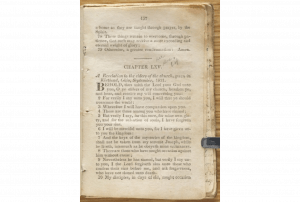Historical Context and Background of D&C 64
Brief Synopsis by Steven C. Harper
Various people who observe the same facts interpret the facts differently. The elders’ trip to Missouri in the summer of 1831 led to the dedication of the site for New Jerusalem and the dedication of a temple site. Some returned from the trip rejoicing and others disappointed. The main voice of discontent was Ezra Booth. He noted the outspoken disagreement between Joseph and Edward Partridge about the Missouri land the Lord designated for Zion. Ezra objected that he and Isaac Morley walked to Missouri while Joseph and his party traveled by stagecoach. Joseph and Bishop Partridge reconciled. Isaac Morley got over it. Ezra Booth, by contrast, would not let his grievances go.1 In that setting the Lord gave section 64.2
The Lord was angry with Ezra Booth and Isaac Morley. They did not obey section 42 or the commandment they received to preach the gospel en route to Missouri in the summer of 1831 (D&C 52:23).3 They had unrighteous desires and therefore lost the Holy Ghost. Then, as so often happens, they projected their own evil onto others. The Lord forgave the repentant Isaac Morley while Ezra Booth was disciplined by the Church as section 64 directed and withdrew from membership.4
The Lord was also upset with Bishop Partridge for arguing with Joseph about the location of Zion (see section 58). He repented in response to section 64. Sidney Gilbert returned to Missouri and established a storehouse there and prepared to buy land for Zion.
Isaac Morley sold his farm as a result of section 64 and thus avoided the overwhelming temptations that the Lord knew would keep him from consecrating otherwise (see section 63:38–40). Frederick Williams consecrated his Kirtland farm to the Church for the Lord to use as a secure headquarters for the Church for five more years. Newel Whitney and Sidney Gilbert kept their Kirtland store and other properties for five years after this revelation.
Section 64 paints a vivid picture and makes an unlikely prophecy. It explains with crystal clarity that the Saints must leave Babylon or perish, the only place other than Babylon is Zion, and the only way to get there is by obeying the law of consecration. The Lord’s promise is that the willing and obedient will see Zion. It will come. They will get there. This is the promise which, according to section 45, the holy had been granted in ages past. They longed for Zion and never got there “but obtained a promise that they should find it and see it in their [resurrected] flesh” (D&C 45:14). Section 64 guarantees Zion tomorrow for those who are willing and obedient to the law of consecration today.
1. See “Historical Introduction” to “Revelation, 11 September 1831 [D&C 64],” p. 108, The Joseph Smith Papers, accessed October 5, 2020.
2. “Revelation, 11 September 1831 [D&C 64],” p. 108, The Joseph Smith Papers, accessed October 5, 2020.
3. Ezra Booth, “Mormonism—No. V,” Ohio Star November 10, 1831, p. 3.
4. “Minute Book 2,” p. 6, The Joseph Smith Papers, accessed October 5, 2020.
Additional Context, by Casey Paul Griffiths
From Doctrine and Covenants Minute
The weeks leading up to the reception of Doctrine and Covenants 64 were difficult for Joseph Smith and other Church leaders. There had been contention among the missionaries during the journey back from Missouri, and when Joseph Smith arrived in Kirtland in late August, he found that several members of the Church in Kirtland had also wandered from the path. In the weeks following his return, the Church held several conferences in which those in apostasy were held accountable for their errors. According to the minutes of these meetings, several elders were “silenced,” a form of ecclesiastical punishment following the guidelines set forth in Doctrine and Covenants 42:74–93. Records show that at least three elders were silenced during these deliberations (Minutes, 1 September 1831, 5, Minutes, 6 September 1831, 6, JSP).
During this time Joseph Smith was also preparing to resume his translation of the Bible. In addition, other groups of Saints were preparing to depart for Missouri, to assist in building the city of Zion. This revelation addresses those Saints by emphasizing the importance of Missouri as the future place of Zion. It also addresses some of the lingering feelings of anger and bitterness felt on the journey from Missouri and the actions taken to quell the apostasy among the Saints in Kirtland.
“Historical Introduction,” Revelation, 11 September 1831 [D&C 64]

